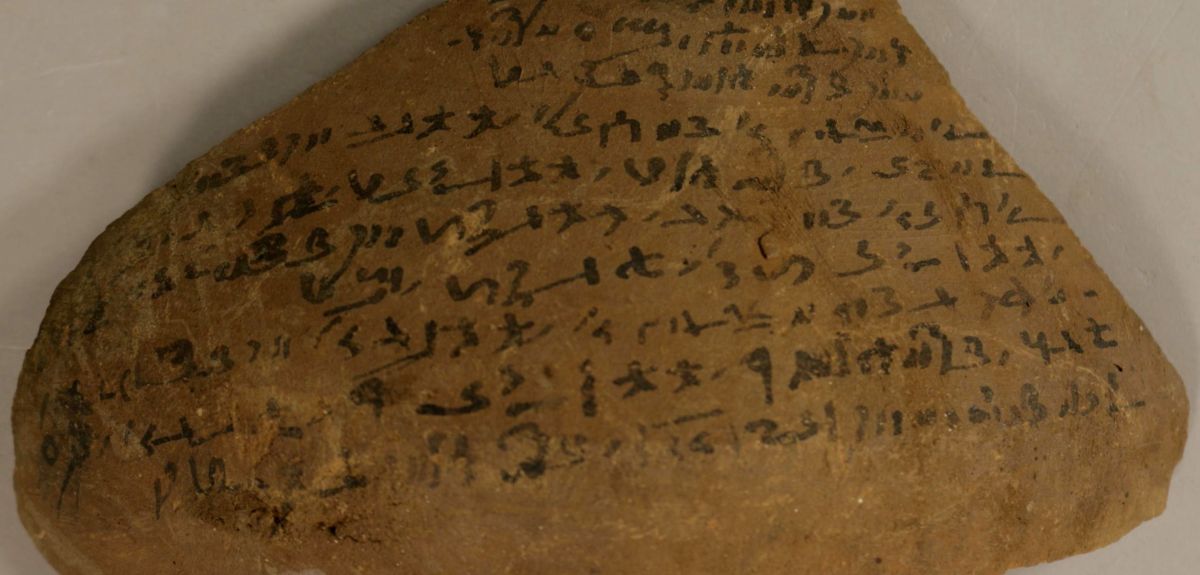
Image credit: Ashmolean Museum
Ancient knowledge transfer: Egyptian astronomy, Babylonian methods
Adapted from an article by Exzellenzcluster Topoi.
Egyptian astronomers computed the position of the planet Mercury using methods originating from Babylonia, finds a study of two Egyptian instructional texts from Oxford's Ashmolean Museum. The study was carried out by Mathieu Ossendrijver, a historian of ancient science at Humboldt University Berlin and Exzellenzcluster Topoi, and Andreas Winkler, an Egyptologist at Oxford University's Faculty of Oriental Studies. The instructional texts date to 1-50 AD and are written in the Demotic language, a late stage of ancient Egyptian, on two 'ostraca' (potsherds, or broken pieces of ceramic material). They are the only known texts from Greco-Roman Egypt with instructions for computing astronomical phenomena with Babylonian methods.
The instructions correspond exactly to methods invented in the ancient state of Babylonia several centuries earlier (400-300 BC). Surprisingly, the ostraca employ a mathematical formulation not found in Babylonian texts but whose existence has long been suspected by historians of astronomy. The ostraca prove that native Egyptian scholars were as competent in Babylonian astronomical computation as their colleagues writing in Greek, suggesting a more important role for native Egyptian scholars in the transmission of Babylonian astronomy to Greco-Roman Egypt than previously thought.
By the early second century BC, Babylonian astrology and astronomy had spread to Egypt. Like their Babylonian colleagues, Egyptian astrologers began to produce horoscopes in order to determine the fate of a newborn. The production of a horoscope required computing the zodiacal positions of the Moon, the Sun and the five planets known in antiquity: Mercury, Venus, Mars, Jupiter and Saturn. Both Demotic horoscopes and Greek horoscopes have been found in Egypt, and in 1999 the American historian of astronomy Alexander Jones proved that some Egyptian astrologers writing in Greek were using Babylonian methods. But until now little has been known about the computational methods of the native Egyptian astrologers writing in Demotic.
The two newly identified Demotic texts with computational instructions shed new light on the mathematical skills of the native Egyptian astrologers. Both ostraca contain instructions regarding three distinct Babylonian algorithms. Each of them is concerned with a particular phenomenon of Mercury: its first appearance as an evening star, its first appearance as a morning star, or its last appearance as a morning star. The inscriptions offer the first unequivocal proof that native Egyptian astrologers, like their colleagues writing in Greek, were capable of computing positions of Mercury, a planet with a comparably complicated motion, using Babylonian methods. An analysis of the instructions suggests that the native Egyptian scholars adapted these methods before their colleagues writing in Greek, as well as independently of those colleagues. First, the ostraca predate all known Greek tables for Mercury that were computed with these methods, and are in fact the only instructional texts with Babylonian astronomy that have been found in Egypt thus far. Second, they use a Babylonian loanword for 'degree', while the astrologers writing in Greek used a Greek word for this.
A surprising aspect of the instructions is that they employ a mathematical formulation that is unknown from Babylonia. While the Babylonians directly computed the variable distance travelled by Mercury along the zodiac – for example, between two occurrences of its first appearance as an evening star – the Egyptian scholars first divided the zodiac into tiny steps of variable length. The distance travelled by Mercury was then obtained by counting off a fixed number of these steps, with identical results to those obtained by their Babylonian counterparts. In 1957, the mathematician Bartel van der Waerden first suggested the existence of this alternative formulation. While it has not yet been identified in any Babylonian text, we now see it in these two Demotic texts written by native Egyptian scholars.